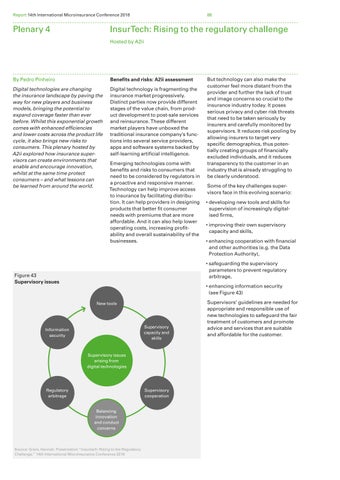Report 14th International Microinsurance Conference 2018
Plenary 4
86
InsurTech: Rising to the regulatory challenge Hosted by A2ii
By Pedro Pinheiro
Benefits and risks: A2ii assessment
Digital technologies are changing the insurance landscape by paving the way for new players and business models, bringing the potential to expand coverage faster than ever before. Whilst this exponential growth comes with enhanced efficiencies and lower costs across the product life cycle, it also brings new risks to consumers. This plenary hosted by A2ii explored how insurance supervisors can create environments that enable and encourage innovation, whilst at the same time protect consumers – and what lessons can be learned from around the world.
Digital technology is fragmenting the insurance market progressively. Distinct parties now provide different stages of the value chain, from product development to post-sale services and reinsurance. These different market players have unboxed the traditional insurance company’s functions into several service providers, apps and software systems backed by self-learning artificial intelligence. Emerging technologies come with benefits and risks to consumers that need to be considered by regulators in a proactive and responsive manner. Technology can help improve access to insurance by facilitating distribution. It can help providers in designing products that better fit consumer needs with premiums that are more affordable. And it can also help lower operating costs, increasing profitability and overall sustainability of the businesses.
But technology can also make the customer feel more distant from the provider and further the lack of trust and image concerns so crucial to the insurance industry today. It poses serious privacy and cyber risk threats that need to be taken seriously by insurers and carefully monitored by supervisors. It reduces risk pooling by allowing insurers to target very specific demographics, thus potentially creating groups of financially excluded individuals, and it reduces transparency to the customer in an industry that is already struggling to be clearly understood. Some of the key challenges supervisors face in this evolving scenario: • developing new tools and skills for supervision of increasingly digitalised firms, • improving their own supervisory capacity and skills, • enhancing cooperation with financial and other authorities (e.g. the Data Protection Authority), • safeguarding the supervisory parameters to prevent regulatory arbitrage,
Figure 43 Supervisory issues
• enhancing information security (see Figure 43) New tools
Supervisory capacity and skills
Information security
Supervisory issues arising from digital technologies
Regulatory arbitrage
Supervisory cooperation Balancing innovation and conduct concerns
Source: Grant, Hannah. Presentation “Insurtech: Rising to the Regulatory Challenge.” 14th International Microinsurance Conference 2018
Supervisors’ guidelines are needed for appropriate and responsible use of new technologies to safeguard the fair treatment of customers and promote advice and services that are suitable and affordable for the customer.























